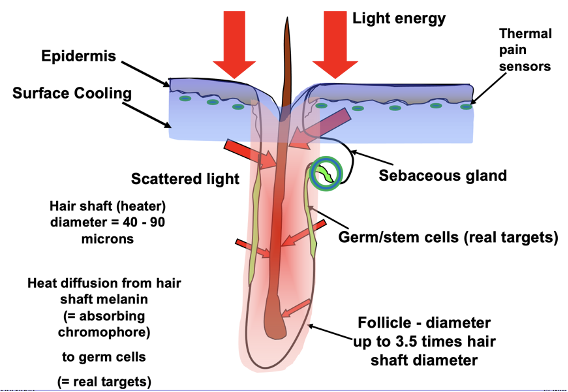Yesterday, I visited a very nice lady to train on the use her very expensive laser. She’d had previous training on laser hair removal but was not obtaining good results. Most of her clients were returning with thinner, finer hairs – yet, she was following the ‘manufacturers’ guidelines’ religiously. What was going wrong? Her machine… Continue reading More on “Manufacturers’ Settings” and how bad they are…
Month: June 2023
When is a laser beam not a laser beam? When it enters the skin…
Laser light is unique due to three particular properties: Monochromacity Divergence Coherence Lasers generate a very narrow band of wavelengths, typically within a few nanometres around a central line. So, a ruby wavelength of 694nm will actually be a spread between 692 and 696nm, depending on how ‘good’ the resonator is. Poor resonators will have… Continue reading When is a laser beam not a laser beam? When it enters the skin…
Time travel… Is it possible?
As some of you know, my background is in physics and astronomy. (Don’t tell me your ‘star sign’ as a smack in the mouth often hurts…!!!) I apply my physics training to lasers and IPLs and stuff, but I don’t really use my astronomy education much, these days. I like to ‘keep up’ by reading… Continue reading Time travel… Is it possible?
Why can’t we treat blonde and grey hair using light?
Well, in fact, we can. Here’s how… Hairs contain melanin. But the concentration of melanin varies enormously. Dark hairs have a high concentration while white/grey hairs have a low concentration. Blonde hair has slightly more melanin than white or grey, but nowhere near as much as dark hair. In treatments, this melanin absorbs red light… Continue reading Why can’t we treat blonde and grey hair using light?
A brief description of laser/IPL hair removal – in 13 comments.
This post describes the 13 main features behind laser/IPL hair removal: 1. Light, usually red, is fired at dark hair (red light can penetrate far into the dermis); 2. The aim is to heat up the melanin in the hair shaft so that the germ cells can be ‘cooked’; 3. This only happens in the… Continue reading A brief description of laser/IPL hair removal – in 13 comments.
Laser tattoo removal of ink colours – Part 3
There’s more… One of my readers, Dan Jackson, asked me about pulsewidth (in a roundabout way) after my recent posts about ink colours (Part 1, Part 2). I had forgotten that the pulsewidth does have an effect on the threshold (minimum) fluences required to instigate the desired response in tattoo ink colours. A few years… Continue reading Laser tattoo removal of ink colours – Part 3
Laser tattoo treatments – how to treat ink colours – Part 2
I recently wrote a post about tattoo ink absorptions and how they vary across the wavelengths we use today (click here for that post). After that, I thought more about the relative fluences required to induce the desired reaction in ink colours. I used the graph which I nicked off the internet (see below) –… Continue reading Laser tattoo treatments – how to treat ink colours – Part 2
Laser tattoo treatments – how do we approach different ink colours??? Part 1.
What is happening with laser tattoo removal treatments? As we all know, the laser energy is absorbed by the tattoo inks, and they ‘break up’. Well, something like that… But what does ‘absorbed’ actually mean? And how much of the light energy is absorbed by each ink colour? To answer these questions, we need to… Continue reading Laser tattoo treatments – how do we approach different ink colours??? Part 1.
Why are some tattoo ink colours so difficult to remove?
Anyone performing laser tattoo removal will know that certain colours are a nightmare! But why is this? What is the science behind this problem? Well, it all comes down to ‘absorption coefficients’. These are the probabilities that an ink colour will absorb any particular wavelength. And, of course, they vary enormously!! Here’s a wee video… Continue reading Why are some tattoo ink colours so difficult to remove?
Manufacturers’ settings – what is wrong with these?
I reckon around 85% of my training clients have been previously trained elsewhere, often by their equipment suppliers/manufacturers. I always ask them why they have come to me when they have already been trained. Their answer is always the same – “I don’t understand what I’m doing!” One client had received her training from a… Continue reading Manufacturers’ settings – what is wrong with these?


